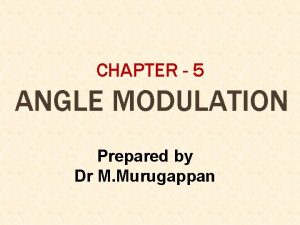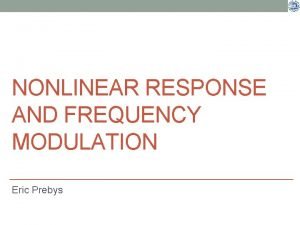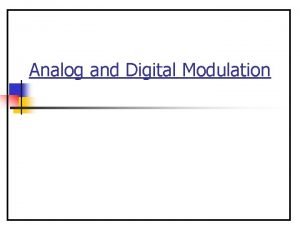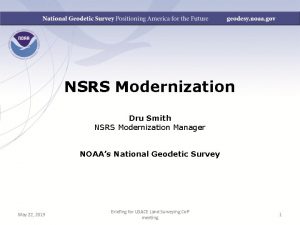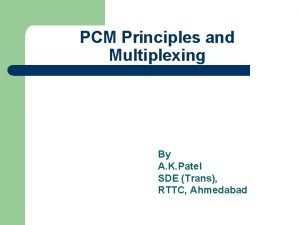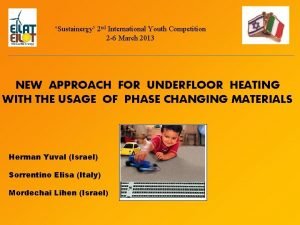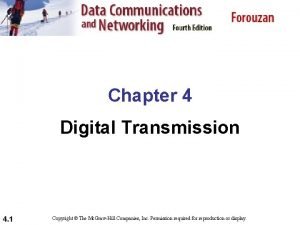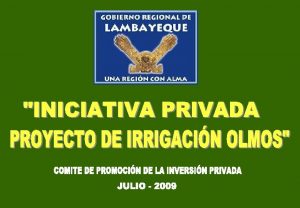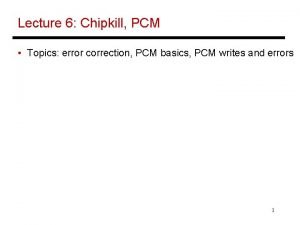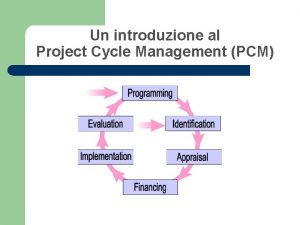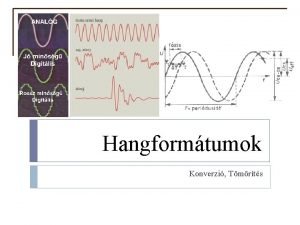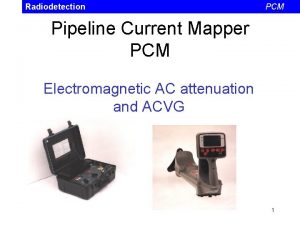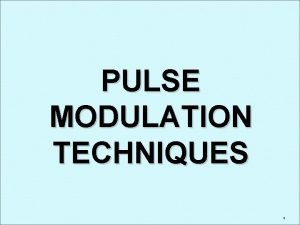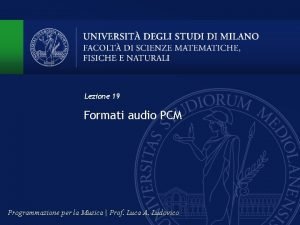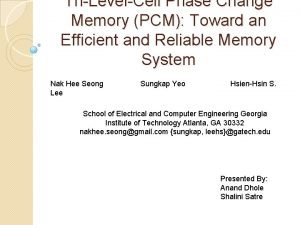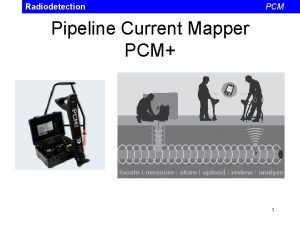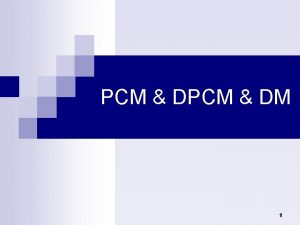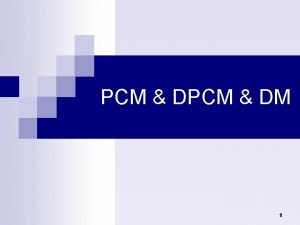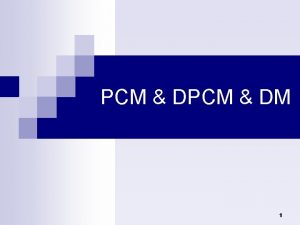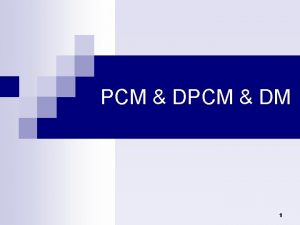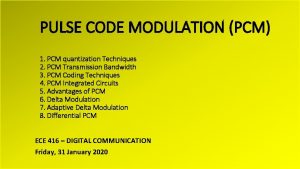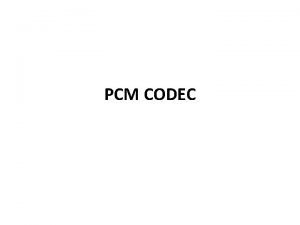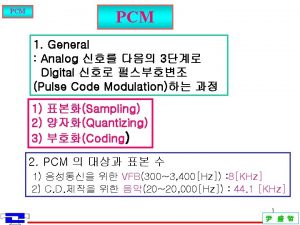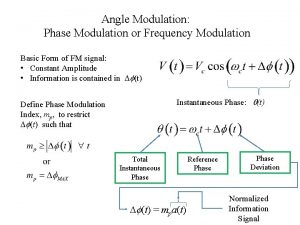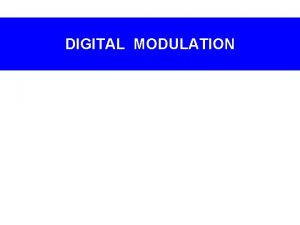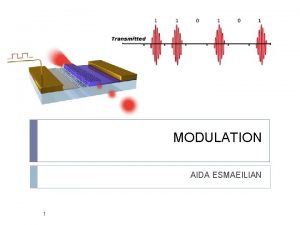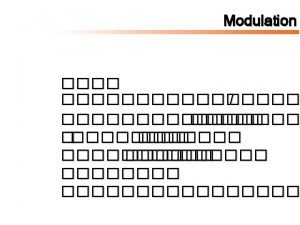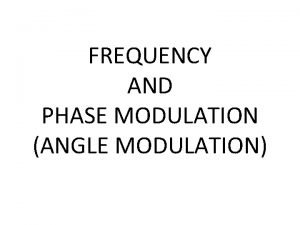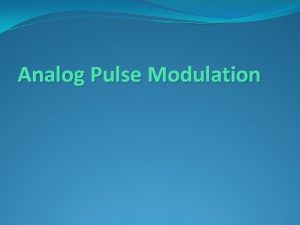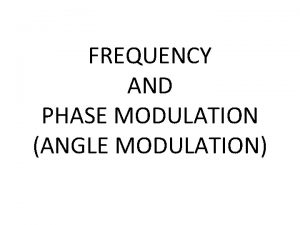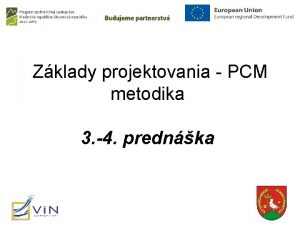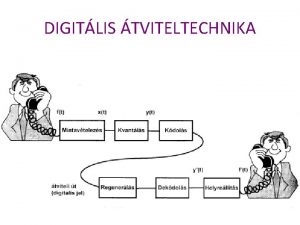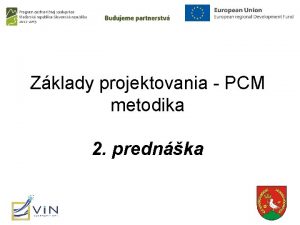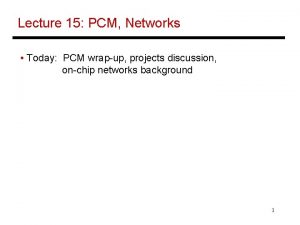PCM DM 1 PulseCode Modulation PCM n In
























- Slides: 24

PCM & DM 1

Pulse-Code Modulation (PCM: ( n In PCM each sample of the signal is quantized to one of the amplitude levels, where B is the number of bits used to represent each sample. ¨ The n rate from the source is bps. The quantized waveform is modeled as : n q(n) represent the quantization error, Which we treat as an additive noise. 2

Pulse-Code Modulation (PCM: ( ¨ The quantization noise is characterize as a realization of a stationary random process q in which each of the random variables q(n) has uniform pdf. n Where the step size of the quantizer is 3

Pulse-Code Modulation (PCM: ( ¨ If : maximum amplitude of signal, ¨ The mean square value of the quantization error is : ¨ Measure in d. B, The mean square value of the noise is : 4

Pulse-Code Modulation (PCM: ( ¨ The quantization noise decreases by 6 d. B/bit. ¨ If the headroom factor is h, then The signal to noise (S/N) ratio is given by (Amax=1) n ¨ In d. B, this is 5

Pulse-Code Modulation (PCM: ( n Example : ¨ We require an S/N ratio of 60 d. B and that a headroom factor of 4 is acceptable. Then the required word length is : ¨ 60=10. 8 + 6 B – 20 ¨ If we sample at 8 KHZ, then PCM require 6

Pulse-Code Modulation (PCM: ( n A nonuniform quantizer characteristic is usually obtained by passing the signal through a nonlinear device that compress the signal amplitude, follow by a uniform quantizer. Compressor A/D D/A Expander Compander (Compressor-Expander) Compressor-Expande 7

Pulse-Code Modulation (PCM: ( n A logarithmic compressor employed in North American telecommunications systems has input-output magnitude characteristic of the form n is a parameter that is selected to give the desired compression characteristic. 8

Pulse-Code Modulation (PCM: ( n The logarithmic compressor used in European telecommunications system is called A-law and is defined as 9

DPCM: n A Sampled sequence u(m), m=0 to m=n-1. n Let be the value of the reproduced (decoded) sequence. 10

DPCM: n At m=n, when u(n) arrives, a quantify , an estimate of u(n), is predicted from the previously decoded samples i. e. , ¨ n ”prediction rule” Prediction error: 11

DPCM: n If is the quantized value of e(n), then the reproduced value of u(n) is: n Note: 12

DPCM CODEC: Σ Communication Channel Quantizer Predictor Coder Σ Σ Predictor Decoder 13

DPCM: n Remarks: ¨ The pointwise coding error in the input sequence is exactly equal to q(n), the quantization error in e(n). ¨ With a reasonable predictor the mean sequare value of the differential signal e(n) is much smaller than that of u(n). 14

DPCM: n Conclusion: ¨ For the same mean square quantization error, e(n) requires fewer quantization bits than u(n). ¨ The number of bits required for transmission has been reduced while the quantization error is kept the same. 15

Delta Modulation : (DM( n Predictor : one-step delay function n Quantizer : 1 -bit quantizer 16

Delta Modulation : (DM( n Primary Limitation of DM ¨ Slope overload : large jump region n Max. slope = (step size)X)sampling freq(. ¨ Granularity ¨ Instability Noise : almost constant region to channel noise 17

DM: Unit Delay Integrator Coder Unit Delay Decoder 18

DM: Step size effect: Step Size (i) slope overload )sampling frequency) ( ii) granular Noise 19

Adaptive DM: Adaptive Function Unit Delay q. This adaptive approach simultaneously minimizes the effects of both slope overload and granular noise 20

Vector Quantization (VQ) 21

Vector Quantization: n Quantization is the process of approximating continuous amplitude signals by discrete symbols. Partitioning of two-dimensional Space into 16 cells. n 22

Vector Quantization: The LBG algorithm first computes a 1 vector codebook, then uses a splitting algorithm on the codeword to obtain the initial 2 -vector codebook, and continue the splitting process until the desired M-vector codebook is obtained. n This algorithm is known as the LBG algorithm proposed by Linde, Buzo and Gray. n 23

Vector Quantization: n The LBG Algorithm : ¨ Step 1: Set M (number of partitions or cells)=1. Find the centroid of all the training data. ¨ Step 2: Split M into 2 M partitions by splitting each current codeword by finding two points that are far apart in each partition using a heuristic method, and use these two points as the new centroids for the new 2 M codebook. Now set M=2 M. ¨ Step 3: Now use a iterative algorithm to reach the best set of centroids for the new codebook. ¨ Step 4: if M equals the VQ codebook size require, STOP; otherwise go to Step 2. 24
 Spectragram
Spectragram Advantages of angle modulation over amplitude modulation
Advantages of angle modulation over amplitude modulation Amplitude modulation vs frequency modulation
Amplitude modulation vs frequency modulation Amplitude modulation vs frequency modulation
Amplitude modulation vs frequency modulation Pcm 30
Pcm 30 Pcm intoxicatie
Pcm intoxicatie Pcm multiplexing
Pcm multiplexing Micronal pcm price
Micronal pcm price Pcm bandwidth formula
Pcm bandwidth formula Decreto supremo nº 059-96-pcm
Decreto supremo nº 059-96-pcm Pcm meaning in project management
Pcm meaning in project management Pcm
Pcm Pcm cycle
Pcm cycle Bitfolyam vagy pcm
Bitfolyam vagy pcm Companding quantization
Companding quantization Pcm pipeline
Pcm pipeline Pcm
Pcm Esadecimale
Esadecimale Teorema de shanon
Teorema de shanon Calculate quantization error
Calculate quantization error Pcm cell
Pcm cell Radiodetection pcm
Radiodetection pcm Pcm imaginer
Pcm imaginer Curs pcm
Curs pcm Pcm frc
Pcm frc

